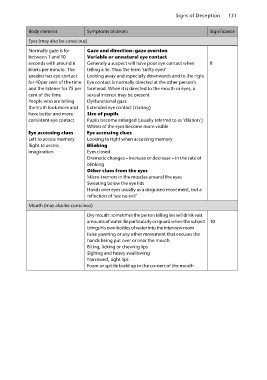Page 90 - Deception at work all chapters EBook
P. 90
Signs of Deception 131
Body element Symptoms of deceit Significance
Eyes (may also be conscious)
Normally gaze is for Gaze and direction: gaze aversion 8
between 1 and 10 Variable or unnatural eye contact
seconds with around 6 Generally a suspect will have poor eye contact when
blinks per minute. The telling a lie. Thus the term ‘shifty eyed’
speaker has eye contact Looking away and especially downwards and to the right
for 40per cent of the time Eye contact is normally directed at the other person’s
and the listener for 75 per forehead. When it is directed to the mouth or eyes, a
cent of the time sexual interest may be present
People who are telling Dysfunctional gaze
the truth look more and Extended eye contact (staring)
have better and more Size of pupils
consistent eye contact Pupils become enlarged (usually referred to as ‘dilation’)
Whites of the eyes become more visible
Eye accessing clues Eye accessing clues
Left to access memory Looking to right when accessing memory
Right to access Blinking
imagination Eyes closed
Dramatic changes – increase or decrease – in the rate of
blinking
Other clues from the eyes
Micro-tremors in the muscles around the eyes
Sweating below the eye lids
Hands over eyes usually as a disguised movement, but a
reflection of ‘see no evil’
Mouth (may also be conscious)
Dry mouth: sometimes the person telling lies will drink vast 10
amounts of water. Be particularly on guard when the subject
brings his own bottles of water into the interview room
False yawning or any other movement that excuses the
hands being put over or near the mouth
Biting, licking or chewing lips
Sighing and heavy swallowing
Narrowed, tight lips
Foam or spittle build up in the corners of the mouth

